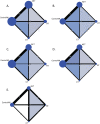Impact of different training modalities on anthropometric outcomes in patients with obesity: A systematic review and network meta-analysis
- PMID: 33624411
- PMCID: PMC8244024
- DOI: 10.1111/obr.13218
Impact of different training modalities on anthropometric outcomes in patients with obesity: A systematic review and network meta-analysis
Abstract
Obesity management guidelines consistently advise aerobic training for weight loss, whereas recommendations for other training modalities are sparse. This systematic review and network meta-analysis (NMA) aimed to compare the long-term effects of different training modalities on anthropometric outcomes in patients with obesity. MEDLINE, Cochrane CENTRAL, and Web of Science were searched to identify the following: (1) randomized controlled trials (RCTs); (2) conducted in adults with a mean body mass index (BMI) ≥30 kg/m2 ; (3) comparing aerobic, resistance, combined, or high-intensity interval training head-to-head or to control for ≥6 months; and (4) reporting changes in body weight (BW), BMI, waist circumference (WC), fat mass (FM), or fat-free mass (FFM). Random-effects NMA models were fitted in a frequentist approach. GRADE framework was used to assess certainty of evidence. Thirty-two RCTs with 4774 participants with obesity were included in this review. Aerobic training was ranked as best for improving BW, BMI, and WC and combined training for improving FM, as well as equally with resistance training most effective for improving FFM. Low to moderate certainty of evidence supports use of aerobic training to improve anthropometric outcomes in obesity, and its combination with resistance training provides additional benefit for reducing FM and increasing FFM.
Keywords: GRADE; aerobic exercise; network meta-analysis; resistance exercise.
© 2021 The Authors. Obesity Reviews published by John Wiley & Sons Ltd on behalf of World Obesity Federation.
Conflict of interest statement
J.M, G.R., A.D., K.P., M.N., S.S., and L.S. declare that they have no conflict of interest.
Figures



Similar articles
-
Drugs for preventing postoperative nausea and vomiting in adults after general anaesthesia: a network meta-analysis.Cochrane Database Syst Rev. 2020 Oct 19;10(10):CD012859. doi: 10.1002/14651858.CD012859.pub2. Cochrane Database Syst Rev. 2020. PMID: 33075160 Free PMC article.
-
Systemic pharmacological treatments for chronic plaque psoriasis: a network meta-analysis.Cochrane Database Syst Rev. 2021 Apr 19;4(4):CD011535. doi: 10.1002/14651858.CD011535.pub4. Cochrane Database Syst Rev. 2021. Update in: Cochrane Database Syst Rev. 2022 May 23;5:CD011535. doi: 10.1002/14651858.CD011535.pub5. PMID: 33871055 Free PMC article. Updated.
-
Interventions for promoting habitual exercise in people living with and beyond cancer.Cochrane Database Syst Rev. 2018 Sep 19;9(9):CD010192. doi: 10.1002/14651858.CD010192.pub3. Cochrane Database Syst Rev. 2018. PMID: 30229557 Free PMC article.
-
Antidepressants for pain management in adults with chronic pain: a network meta-analysis.Health Technol Assess. 2024 Oct;28(62):1-155. doi: 10.3310/MKRT2948. Health Technol Assess. 2024. PMID: 39367772 Free PMC article.
-
Low-carbohydrate versus balanced-carbohydrate diets for reducing weight and cardiovascular risk.Cochrane Database Syst Rev. 2022 Jan 28;1(1):CD013334. doi: 10.1002/14651858.CD013334.pub2. Cochrane Database Syst Rev. 2022. PMID: 35088407 Free PMC article.
Cited by
-
Prescription and Effects of Cardiorespiratory Training in Individuals with Intellectual Disability: A Systematic Review.Healthcare (Basel). 2023 Jul 24;11(14):2106. doi: 10.3390/healthcare11142106. Healthcare (Basel). 2023. PMID: 37510547 Free PMC article. Review.
-
Effect of aerobic exercise on waist circumference in adults with overweight or obesity: A systematic review and meta-analysis.Obes Rev. 2022 Aug;23(8):e13446. doi: 10.1111/obr.13446. Epub 2022 Apr 5. Obes Rev. 2022. PMID: 35383401 Free PMC article.
-
Exercise training in metabolic and bariatric surgery: An overview of systematic reviews.Obes Rev. 2025 Aug;26(8):e13920. doi: 10.1111/obr.13920. Epub 2025 Apr 6. Obes Rev. 2025. PMID: 40189410 Free PMC article. Review.
-
Effect of 5:2 Regimens: Energy-Restricted Diet or Low-Volume High-Intensity Interval Training Combined With Resistance Exercise on Glycemic Control and Cardiometabolic Health in Adults With Overweight/Obesity and Type 2 Diabetes: A Three-Arm Randomized Controlled Trial.Diabetes Care. 2024 Jun 1;47(6):1074-1083. doi: 10.2337/dc24-0241. Diabetes Care. 2024. PMID: 38638032 Free PMC article. Clinical Trial.
-
Comparative efficacy of different exercise types on body composition in university students: a systematic review and meta-analysis of randomized controlled trials.Front Physiol. 2025 Apr 22;16:1537937. doi: 10.3389/fphys.2025.1537937. eCollection 2025. Front Physiol. 2025. PMID: 40330251 Free PMC article.
References
-
- World Health Organization . Obesity: Preventing and Managing the Global Epidemic. Geneva: World Health Organization; 2000. - PubMed
-
- Abdullah A, Peeters A, de Courten M, Stoelwinder J. The magnitude of association between overweight and obesity and the risk of diabetes: a meta‐analysis of prospective cohort studies. Diabetes Res Clin Pract. 2010;89(3):309‐319. - PubMed
Publication types
MeSH terms
LinkOut - more resources
Full Text Sources
Other Literature Sources
Medical

